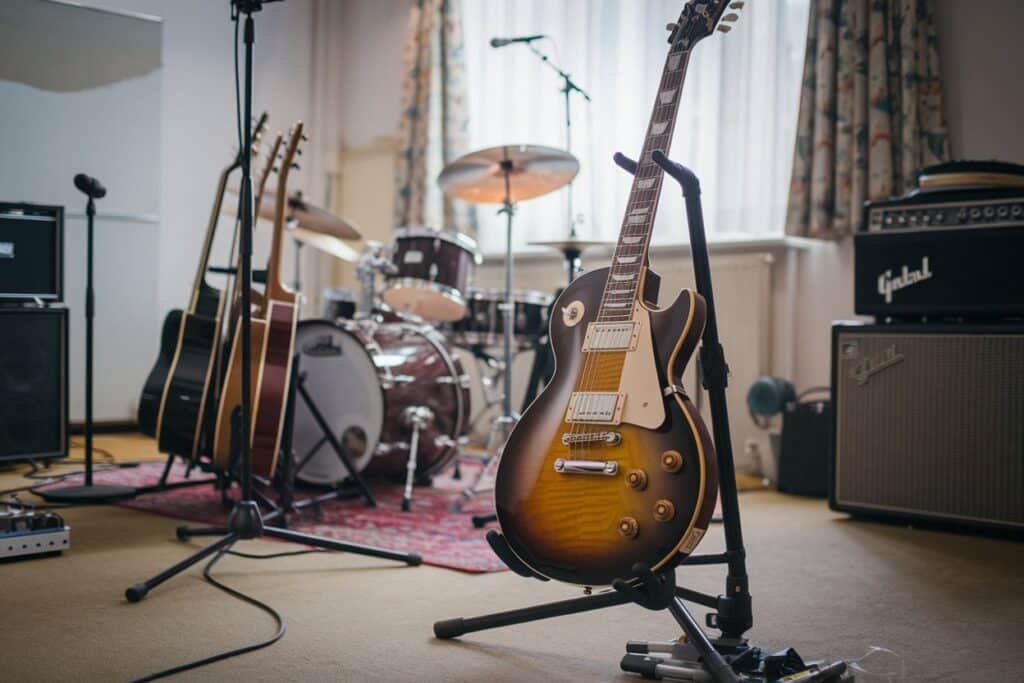Mahogany tonewood has been the backbone (or should I say, the body) of so many iconic guitars.
Whether you’re an acoustic strummer or an electric shredder, this wood has probably influenced your sound more than you know.
Today I’m going to tell you about 7 things that you need to know about this material.
Quick Overview for Those in a Rush
Hey, we get it. You’re busy. Here’s a cheat sheet for what makes mahogany special:
- Warm Sound: Mahogany gives a rich, full-bodied tone, perfect for all you blues and rock lovers.
- Versatile: Works great for both electric and acoustic guitars. It’s like that friend who’s comfortable at both a metal concert and a coffee shop gig.
- Sustain and Balance: If you love sustain (and who doesn’t?), mahogany’s got your back.
- Looks Amazing: Dark and beautiful—kinda like your brooding teenage years.
Now, let’s get into the good stuff.
1. Density Of Mahogany Tonewood

First up, density. Mahogany is denser than your average wood (but let’s not get carried away—it’s not granite). And FYI, different types of mahogany have different densities, which influences their tonal characteristics:
- African Mahogany: 500 – 850 kg/m³
- Cuban Mahogany: 660 kg/m³
- Honduras Mahogany: 650 kg/m³
- Spanish Mahogany: 850 kg/m³
This variation in density means mahogany packs a serious punch in the lower-midrange frequencies, giving you a warm, almost chocolatey tone.
If you’re an acoustic player, you’ll appreciate the richness and depth it brings. For electric players, it’s like adding a touch of growl to your sound.
It’s like when you add a bit of extra weight to your deadlift—you feel the impact immediately. The density of mahogany gives you sustain for days, which makes your solos sound fuller and more expressive. Think Santana vibes: long, soulful, and rich.
2. Warm Sound that Feels Like a Hug
Ever heard someone describe a guitar’s sound as „warm” and wondered if they were just making it up? Mahogany genuinely delivers that warmth. It’s the sonic equivalent of a cozy blanket on a cold day, or like that barista who knows exactly how you like your coffee.
Example of a guitar with warm tone: Harley Benton CG-45. This cheap guitar sounds really warm and I had the pleasure to test it out! Another great example is Guild M-20, but it’s far more expensive.
Mahogany balances your highs and lows, making it great for both leads and rhythm. There’s enough brightness to cut through the mix, but it won’t leave your ears ringing (lookin’ at you, maple). In a world full of buzz and harsh trebles, mahogany’s warmth is the hero we need.
3. Mahogany Is Used For Both Acoustic & Electric Guitars
Whether you’re strumming a campfire song or ripping a face-melting solo, mahogany works for both. On acoustics, it brings depth and resonance to your tone.
A full mahogany-bodied acoustic guitar can make even a basic chord progression sound like a symphony.
On electrics, mahogany has been used on some of the most iconic guitars ever. (You know, just a little thing called the Gibson Les Paul.)

It provides that punchy sustain and rounded midrange that makes power chords sound epic and single notes feel soulful.
4. It’s a Heavyweight (Literally and Figuratively)
Yes, mahogany is heavy—and I mean that both physically and sonically. When you pick up a mahogany guitar, you’ll notice it’s not exactly featherweight. But hey, that’s what makes you look cool on stage: struggling just a little to hold it up while you’re nailing that solo.
The weight gives you stability and contributes to the sustain (more mass, more resonance—simple physics, folks). If you’re into long, droning notes that sing out beautifully, a mahogany guitar can help you get there.
5. It Looks So Damn Good

You can’t talk about mahogany without talking about its looks. The deep, rich, reddish-brown color is just… classic. Whether it’s glossed up or left natural, mahogany always looks sick.
If your guitar’s looks are as important to you as its tone—and come on, we ALL care at least a little – this tonewood is the way to go.
It’s like dressing up in a sharp suit: mahogany makes your guitar look as good as it sounds. Plus, it ages like a fine wine, getting even more stunning over time. Compare that to those neon-colored guitars that age like milk.
6. Mahogany’s Personality in a Mix
Playing in a band? You want a guitar that sits in the mix nicely, not one that bulldozes over the bass and drums. Mahogany gives you a balanced tone that’s strong but never overpowering.
The mids are rich, the lows are tight, and the highs are present without stabbing your ears. It’s like that one person at a party who tells great stories but doesn’t dominate the conversation—everyone loves them.
If you play rhythm guitar, mahogany gives you the power to keep the song grounded. For leads, it’s smooth enough to stand out without being overbearing. Basically, it’s the tonewood equivalent of good manners.
7. It’s All About Sustainability (The Kind That Doesn’t Just Mean Your Solos)

Not to get too serious, but sustainability matters. A lot of mahogany used today comes from plantations, and many guitar brands have switched to using sustainable sources for their mahogany. That means you get to enjoy a killer tone without contributing to deforestation. Pretty sweet, right?
Besides, taking care of the planet is kinda cool. After all, what good is nailing that solo if there’s no one left to hear it?
Mahogany vs. Other Tonewoods
Let’s face it, mahogany isn’t the only wood in the game. Here’s how it stacks up against some other popular tonewoods:
| Tonewood | Tone Characteristics | Weight | Best For |
|---|---|---|---|
| Mahogany | Warm, rich, balanced mids | Heavy | Blues, Rock, Soulful Tones |
| Maple | Bright, articulate, crisp | Medium to Heavy | High-energy genres, Leads |
| Rosewood | Complex, rich with overtones | Heavy | Fingerstyle, Indie, Acoustic |
| Alder | Balanced, even spread across frequencies | Light to Medium | Versatility, All-Round Genres |
| Ash | Snappy, bright, dynamic | Medium | Rock, Country, Attack Focused |
So yeah, mahogany holds its own with warmth and depth, while other tonewoods bring their unique flavors to the table. Of course, there are a lot of other tonewoods out there. For example exotic Bubinga – which has a bit larger density.
FAQs
1. Is This Wood a Good Choice for Guitars?
Absolutely, it’s a top-tier choice for guitars. Known for its warm tone, durability, and beautiful aesthetic, this wood provides a well-rounded sound that suits a wide range of genres, whether acoustic or electric.
2. Do These Guitars Age Well?
Yes, they do! In fact, guitars made from this wood tend to get better with age. As the wood matures, the tone often becomes even richer and more resonant, which is why vintage models are so highly valued.
3. What Are the Disadvantages?
One of the downsides is the weight—this type of wood tends to be heavier than others. Plus, due to its popularity and slow growth, it can be more expensive compared to other woods. But hey, you usually get what you pay for in terms of quality.
4. How Does It Compare to Maple?
It depends on what you’re looking for. This wood offers warmth and richness, while maple delivers brightness and clarity. If you’re into smooth, soulful tones, this one’s for you. For a sharp attack and punchy highs, maple might be a better fit.
5. Is This Considered a Luxury Material?
You bet. It’s often considered a luxury wood because of its premium quality, beautiful aesthetics, and excellent tonal properties. It’s used in high-end instruments and furniture, giving it a luxurious reputation.
6. Are There Alternatives That Might Be Better?
Well, “better” is subjective, but there are alternatives depending on your needs. Maple is brighter, rosewood has more overtones, and alder is super versatile. Each wood has its own unique characteristics, so it’s about finding what matches your style.
7. How Does Humidity Affect These Guitars?
This wood is relatively stable, but it can still react to humidity. High humidity can cause swelling, and low humidity can lead to drying out. Keep your guitar in a controlled environment to prevent warping or cracking.
8. Are There Any Famous Guitars Made from This Wood?
Oh, absolutely. The Gibson Les Paul is probably the most iconic. Many of Gibson’s models, as well as Martin’s acoustics, use this wood for their rich, sustaining tone. If it’s good enough for legends like Slash and Jimmy Page, it’s probably good enough for the rest of us.
Final Thoughts

Mahogany isn’t just a tonewood—it’s a mood. It gives your guitar a rich, balanced sound, a look that stands out, and a feel that’s hard to beat. Whether you’re looking for a reliable acoustic or an electric that sings with sustain, mahogany is a solid choice. It’s not just hype; it’s the real deal.
If you want more awesome guitar content, be sure to check out our YouTube channels: Strefa Gitar and Best Guitars Now. We’ve got tips, demos, and probably more bad jokes—because hey, we’re guitarists, not comedians.
Now go pick up that mahogany beauty and play something amazing. Or at least try not to butcher „Wonderwall” again, okay? 😉





